Of all the times to live in throughout history the Medieval period was probably one to avoid. Roughly speaking Medieval times (or the Middle Ages) started at the end of the Roman Empire, around 500 AD, and continued until around the 1500s. Whilst I’m sure plenty of lovely things happened during this time none of them spring to mind – all I can think of is war, poverty and plague. Things seemed to get worse as time went by culminating in the Black Death and the Spanish Inquisition, that orgy of sadism and torture.
By the end of the Medieval period torture had become a fine art. Even with all our technology and medical knowledge there wouldn’t be much chance of coming up with any more terrifying torture instruments than this lot. Yes, now-a-days we could probably develop more effective ways of getting information out of people, but that doesn’t seem to have been the point of half these. For the record the main users of these forms of torture were the various churches of the day in the name of Christianity.
The methods of torture below are all European in origin. The Chinese and Japanese had plenty of equally unpleasant torture techniques which I’ll get round to covering another time.
10. Heretic’s fork
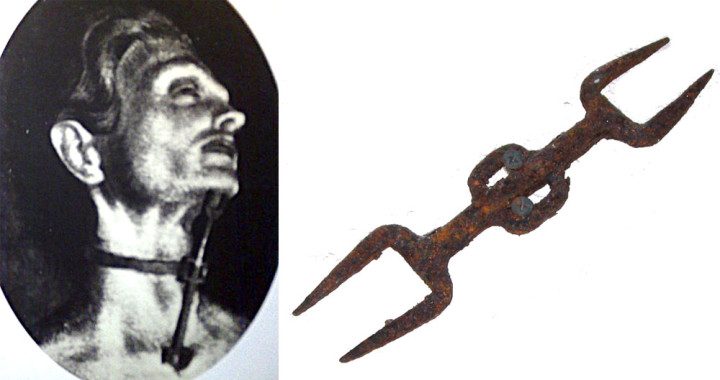
Despite looking fairly inoffensive this little device is not only great for toasting marshmallows but is all you need to get a confession out of the toughest of heretics, sinners and blasphemers. It’s actually quite ingenious and ever so compact.
As you can see in the picture above the “fork” is strapped around the neck and placed with the sharp prongs just digging into the base of the throat and underneath the chin. The victim would be restrained so they were upright, either by hanging from the ceiling or tying to a chair. Then they were left…
Anyone wearing the heretic’s fork is unable to fall asleep – the moment they did the prongs would pierce the skin causing more than enough pain to wake them up. After a few days of this torture they would be so sleep deprived that they’d confess to anything.
Popular with the Spanish Inquisition these little horrors were usually engraved with abiuro, the Latin for “I recant”. And recant they did!
9. Hanging
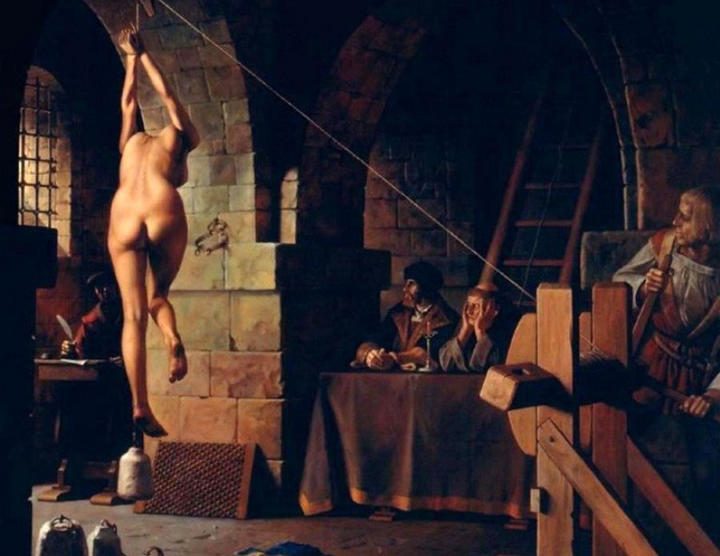
When it says “hanging” above we’re not referring to good, honest, straightforward neck-snapping, strangulating hanging. No, that would be far too humane for the Medieval sadists. Here we are talking about the many variants of hanging that were excruciatingly painful forms of torture. This generally involved suspending the victim by one or more of their limbs, often with the aid of weights and sometimes with the added torment of spikes.
The most popular of these torture techniques is strappado, which is still popular today. The usual form this takes is to tie the victims arms behind their back and then suspend them from the wrist. Now, you’ve probably worked out that your arms don’t really want to go that way and this causes intense pain as the shoulders will probably be dislocated.
Again this was a favourite with the Spanish Inquisition and they had a few twists to make it even more painful. One was to let the victim drop a little and then check the rope suddenly multiplying the pain manyfold.
The other variant, known as sqaussation, involved the victim being suspended by their wrists and having more and more weights hung from them. As you can see in the picture above they’re mixing it right up.
8. Crushing
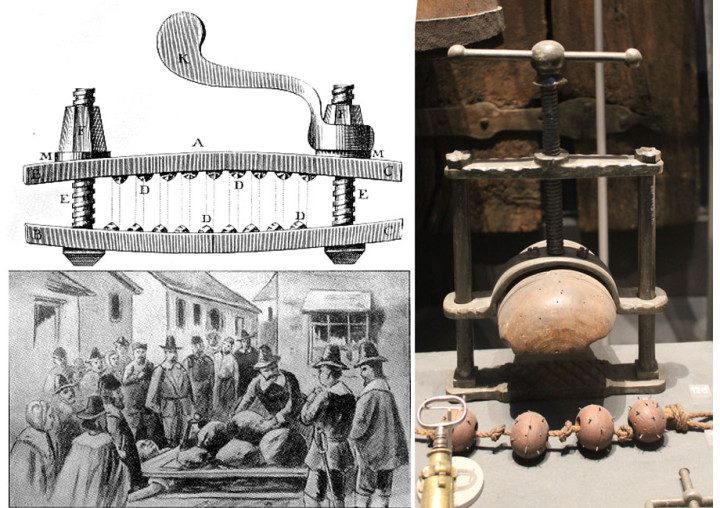
Even before the invention of the vise crushing the various appendages was a popular form of torture. The earliest methods would see the victim sandwiched between a pair of boards and more and more weight piled on top. If they didn’t confess or spill the beans then they would end up being crushed to death. If they did, they would also probably end up being crushed to death.
With advances in screwing technology came a wonderful new array of torture implements designed to crush with merciless precision. Portable devices such as the thumbscrew were very popular and no inquisitor would go anywhere without a set. However, the must have torture instrument was the head crusher (above right). As the name suggests it would slowly crush the victims head as the handle was turned. The obvious problem with the head crusher is the victim can’t really talk whilst it is crushing their jaw into their skull. But who cares when you can look forward to the accused’s eyes popping out of their sockets when the skull finally cracks.
7. Barrel Pillory
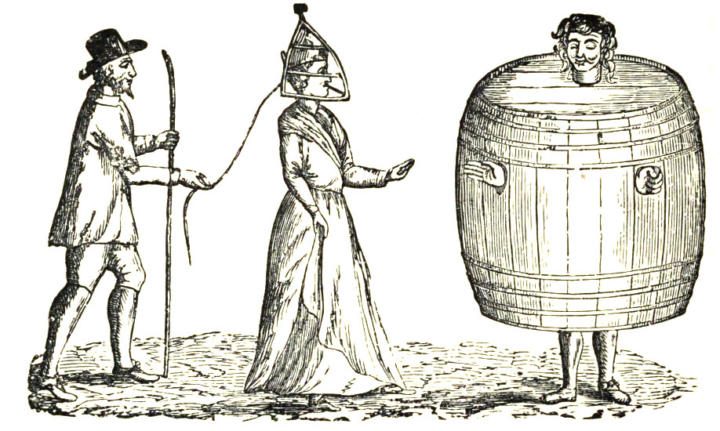
Also known as the Spanish Coat or Schandmantel this fairly innocuous looking set up was actually fairly horrific when carried out to its logical conclusion. It came in a few varieties including “barrel pillory lite” otherwise known as the drunkard’s cloak. This version was more a form of humiliation with the wearer being left to walk the streets wearing the barrel. The chap in the picture above looks quite lucky in that he has his hands free, but just think about what happens when he needs a sh..
The hardcore version of this used a similar set up except there are no leg holes in the bottom. What this means is there was nowhere for their excrement to go and they would have to kneel there for days on end in their own filth. That is pretty bad but in the worst cases this would begin to attract insects. This is known as scaphism with the insects breeding and eating within the victims, by now, probably rotting flesh. Death would be inevitable from any combination of starvation, dehydration or septic shock.
6. Chair of Torture / Iron Chair
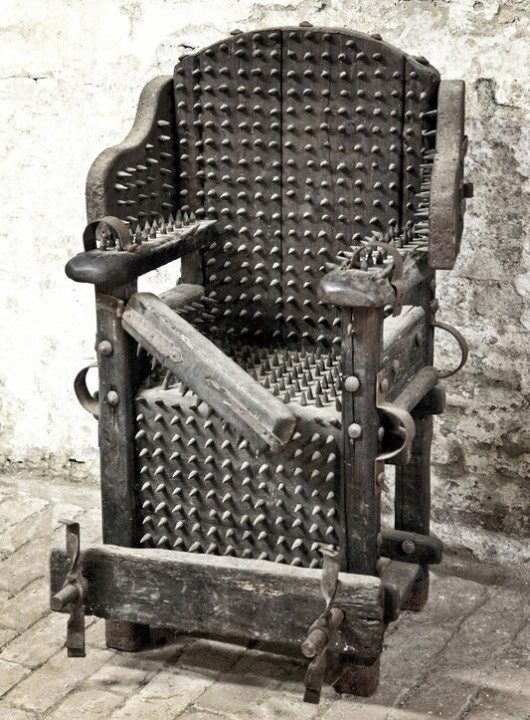
As its name suggests the chair of torture is a chair that has been liberally upholstered with spikes. Also known as the Judas or Iron chair these elaborate devices could have as many as 1,500 spikes. Looking at the above chair it could well be the deluxe model.
Obviously just sitting on such a chair is not going to generate quite the required level of pain so the various restraints could all be tightened to make sure the spikes went in good and deep. If that wasn’t enough a popular feature was having fire feature that would roast your buttocks to a crisp.
Whilst probably not intended to kill the blood loss from all those punctures must have been quite significant and the infection would almost certainly kill you if nothing else.
5. Pear of Anguish
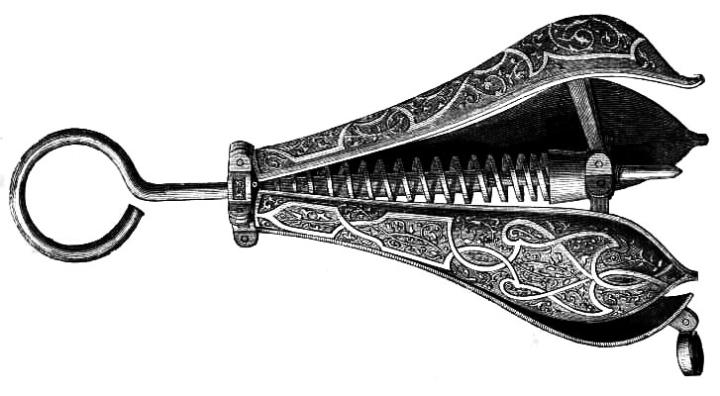
Don’t be fooled by the wonderfully decorative design of the “agonising pear”. As you can see it is roughly pear shaped but that is where any similarity with the fruit ends. It was a favoured form of punishment for women who’d had abortions, homosexuals, blasphemers and liars. Any ideas yet where this is going?
The pear consists of four leaves that open away from each other as the screw at the top is turned becoming wider and wider at the base. Its mode of use was to insert it into the offending orifice. So this could be the anus, vagina or mouth. Once in place the crank was turned – how far depended on the sadistic whim of the torturer.
4. The Rack

The rack was popular throughout Europe in the Middle Ages. For those who don’t know, the rack involves the victim being laid out with feet tied to one end and hand to the other. Then the pressure was applied stretching the poor unfortunate. Except they didn’t really stretch. As the ropes were pulled tighter the bones would dislocate from each other with a sickening crack as the cartilage and ligaments snapped. Further ratcheting up of the force would eventually tear the victim limb from limb.
It was introduced to Britain in 1447 by the Duke of Exeter and was referred to by torturers as “being put to the question”. Notable victims included Guy Fawkes and William Wallace. The rack was eventually banned in the UK in 1628.
Variations and improvements on the basic rack included the use of spiked rollers. These would dig into the back and spine as the pressure was hiked up.
3. Iron Maiden
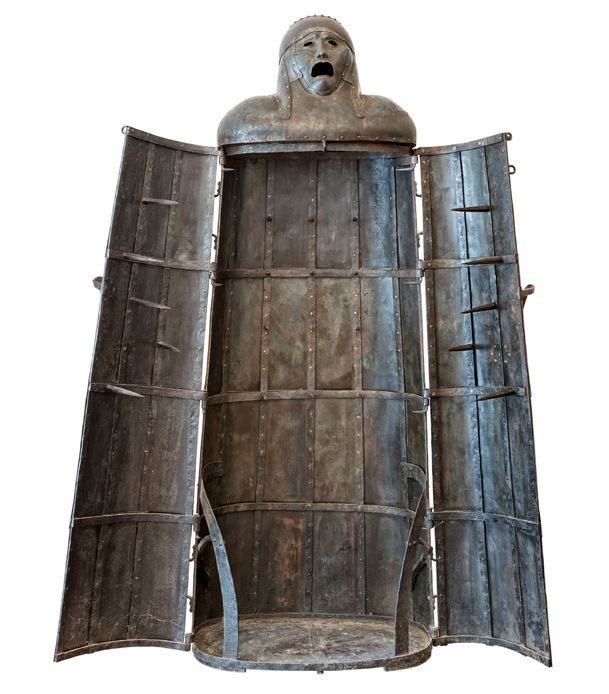
Named after the legendary 1980s British metal band is the iron maiden – or was it the other way around…
The design is simple, a man-sized cabinet lined with spikes, you can probably imagine the rest.
I always thought that the iron maiden was used as a form of execution, which it was. One record dating back to 1515 tells of a counterfeiter being executed with such a device:
“…was placed inside, and the doors shut “slowly, so that the very sharp points penetrated his arms, and his legs in several places, and his belly and chest, and his bladder and the root of his member, and his eyes, and his shoulders, and his buttocks, but not enough to kill him; and so he remained making great cry and lament for two days, after which he died”.
Apparently there was another use for the maiden. In some designs the blades would not pierce the prisoner’s skin even after the doors were shut tight. They also wouldn’t allow them to move an inch in any direction. The sharp edges would be there waiting for you, not allowing even the briefest rest whilst an interrogator screamed questions at you and then left you unable to move a muscle.
2. Rat Torture

Amongst the most cheap and cheerful forms of torture is rat torture. They are free and there is a practically unlimited supply – ideal for cash-strapped sadistic despots.
The basic premise is the rat is encouraged to eat the live victims flesh. Nice! This can take several forms the most straightforward being put hungry rats in a cage with the victim restrained. OK, that sounds pretty bad, but the level of ingenuity that has gone into some of these torture methods is just sick.
In Medieval Holland it is said that rats would be put into a bowl that was attached face down to the stomach of the prisoner. The bowl would then be heated up to force the rats to eat into the bowels of the victim in an attempt to escape. A similar method was to cut slits into the victim’s belly in which rats were put and would gnaw into the flesh.
Rat torture was apparently used as recently as the 1980s in Pinochet’s Chile and in neighbouring Argentina.
1. Judas Cradle

Another engineering masterpiece from the Spanish Inquisition was the Judas cradle. As you can see above the victim would be suspended in a harness above a wooden pyramid. You can probably figure out where the sharp end of that big wooden triangle is going. For ladies it was different, but equally painful I’m sure.
As the torture session proceeded the victim would be lowered further onto the pyramid. This would stretch to orifice to breaking point, at which point the muscles would tear. The torturers could control the degree of pain by oiling up the pyramid and/or dropping the victim onto it repeatedly. The process could be short or it could continue for days with the victim being left suspended overnight.
If the torturer decided to finish the victim off quickly then weights could be added until the person was effectively impaled. It is said that the Judas cradle was rarely, if ever washed. So, even if someone did get off the cradle alive the chances are the subsequent infection would probably kill them.



Scaphism must be a horrible way to die. Bound between two boats floating in you own secrement and puke while eaten alive by insects.
Meantime the burning sun on your face and your hands outside not possible to scratch.
All those insects make you become hysterical of the itching and bites.
It was said that most became mental crazy before they died of sceptic shock….
Another questionable search… I swear I’m a writer. Research just ends up weird when. Fun fact people are recreating some of the lesser torture devices as sex toys… Yo ho a writer’s life for me -_-
Why not just stick something sharp into the butt?
Judas Chair?
Because the victim dies of shock, as Vlad Tepes knew. The trick is to shove something BLUNT up the butt so they’re still alive as they’re pulled down onto it.
This should be used on animal abusers and serial killers
I agree. Many people are not being respectful to both animals and humans.
What if they turn out to be innocent after? You can release someone from prison but it’s very difficult to un-spike a bottom.
The case that broke the death penalty in England involved a man with mental health issues who was framed for multiple murders by the real culprit. The deception was discovered eventually, but not before the poor man died on the gallows.
Can you find these on ebay?
yes, but actually no
What about the brazen bull isn’t that used in medieval torture ?
They are only talking about the top ten WORST
Even I was confused until I read the title again
How can you forget “le supplice du baquet ” by far the most horrible of all
That’s basically a barrel pillory – #7 in the list.
The iron maiden is a myth.
Possibly, but there are apparently some early mentions of similar devices – including the one mentioned in the article.
Several historians claim to have debunked that particular account as being invented by Johann Philipp Siebenkees. It’s worth noting though that similar devices are also purported to have been used in Ancient Sparta and in 9th century Iraq – but since the article is about Europe in the Middle Ages, they lie outside of the scope of the article. Most of the history of the European use of the Iron Maiden is very sketchy before the 19th century.
I have seen them on tours through Europe and museums.
Me too; they are quite interesting to study about but at the same time pretty disgusting.